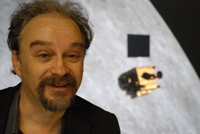Moon mission

Professor Manuel Grande
20 October 2008
Scientists at Aberystwyth University are keeping a very close eye on proceedings in India as final preparations are made for the launch of the Chandrayaan-1 space craft, the country's first mission to the Moon, on Wednesday 22nd October.
Professor Manuel Grande is Head of the Solar Systems Physics Group at the Institute of Mathematics and Physics at Aberystwyth University, and Principal Investigator on a sophisticated X-ray camera which forms the UK contribution to the mission.
The camera, C1XS, was designed and built at STFC Space Science and Technology Department in the Rutherford Appleton Laboratory. It is an X-Ray Spectrometer that will measure X-rays to map the surface composition of the Moon which will help scientists to understand its origin and evolution, as well as quantifying the mineral resources that exist there.
Chandrayaan-1 is the first lunar mission from the Indian Space Research Organisation (ISRO). It is designed to orbit the Moon and carries radar and particle detectors as well as instruments that will make observations in the visible, near infrared and X-ray part of the electromagnetic spectrum.
Prof Manuel Grande, C1XS Principal Investigator, Aberystwyth University, said, “The C1XS instrument will provide us with a new picture of what the Moon is made of; not just here and there, but over the whole surface of our eighth continent. This will enable us to pin down the mysteries which remain about the origin of the Earth-Moon system.”
Dr Ian Crawford from Birkbeck College, who chairs the C1XS Science Team, said,
“There is still a lot we don't know about the Moon. Accurate maps of the surface composition will help us unravel its internal structure and geological history. We will learn more about what happened on the Moon since it formed and how and when it cooled. By peering into its craters, we may even be able to see below its crust to the material underneath.”
C1XS was developed in conjunction with the Indian Space Research Organisation. It employs new technology to make a compact, lightweight, sensitive instrument that can measure the abundances of chemical elements in the lunar surface, by detecting the X-rays they absorb and re-emit. The spectrometer builds on a successful technology demonstration called D-CIXS, which was launched aboard the European Space Agency’s (ESA) Smart-1 mission to the Moon.
C1XS will work by looking at X-rays from the Sun which have been absorbed by atoms in the lunar soil, then re-emitted in such a way as to reveal the make-up of the surface. The spectrometer is sensitive to magnesium, aluminium and silicon X-rays. When the solar X-ray illumination is bright, for example during a solar flare, it may also be able to make measurements of other elements such as iron, titanium and calcium. To make accurate measurements of the surface elements it is essential to measure the X-rays being produced by the Sun. C1XS has an additional detector system to measure these X-rays called the X-ray Solar Monitor (XSM) which is provided by the University of Helsinki Observatory, Finland.
Dr Tony Cook, of Aberystwyth University, a leading expert on mapping the Moon said “In the long run, these maps can tell us the best places to look for natural resources on the Moon”
“C1XS uses an advanced version of conventional CCD sensors such as you might find in a digital camera, called swept charge devices. These are mounted behind a gold/copper ‘collimator’, which limits the field of view of the X-ray detectors to a narrow beam. Together these two innovations form an X-ray camera that has high resolution allowing identification of the surface elements, yet is far more compact and lower mass than other spacecraft’s X-ray spectrometers.” said Chris Howe, C1XS Chief Engineer, from STFC Space Science and Technology Department.
Prof Grande concluded, “In the UK we are rapidly becoming the world's leading maker of planetary X-ray instruments. C1XS will cement this position, and paves the way for UK leadership of similar instruments at Mercury and elsewhere in the Solar System.”
Chandrayaan-1
Details of the Chandrayaan-1 mission are available online at http://www.isro.org/chandrayaan/htmls/home.htm.
C1XS
C1XS is a joint UK-Indian instrument with a diverse range of national and international collaborators from both research and academic institutions. A full list of participating institutions and details of the mission are available at http://www.sstd.rl.ac.uk/c1xs/CO-I.htm.
Participating UK Institutions:
Aberystwyth University, STFC Rutherford Appleton Laboratory, Birkbeck College, Brunel University, University College London.
Facts
• Chandrayaan-1 is expected to launch from Satish Dhawan Space Centre at Sriharikota (SHAR), India at 2.00a.m. on Wednesday 22 October 2008.
• Within a week from launch Chandrayaan-1 will reach the Moon.
• Chandrayaan-1 will orbit the Moon at a height of 100km.
The Institute of Mathematics and Physics, Aberystwyth University
The new Institute of Mathematics and Physics, which embraces two of the oldest and scientifically distinguished departments, Mathematics and Physics, was launched by Aberystwyth University in August 2003. Established shortly after the University was founded at Aberystwyth in 1872, these subjects were taught from the start and continue today with over 300 undergraduate and postgraduate students, including many from abroad.
The Institute of Mathematics and Physics supports three major groups competing at the forefront of world science. The Solar System Physics group studies the chain of events leading from the Sun, through the solar wind, to the atmospheres and surfaces of the planets.
In Materials Research, advanced experimental techniques are applied in parallel with mathematical and computational modelling to elucidate the critical relationships that determine properties such as fluid flow, fracture, melting, conductivity and light emission in materials such as liquids, foams, glass, ceramics, semiconductors, nanoparticles and thin films.
Research interests in Mathematics cover a broad field that includes analysis, mathematical modelling, open quantum systems and algebraic combinatorics. Researchers in all groups are involved in wider collaborations and are active partners in the Centre for Advanced Functional Materials and Devices (CAFMaD) and the Wales Institute for Mathematical and Computational Sciences (WIMCS).



